The Society's Projects
Abercarn Blast Furnace
Having known a particular derelict building for many years, three members of the society identified it as the second Abercarn Blast Furnace of 1753 and carried out a study of the remaining structure. 'Abercarn Blast Furnace' by Foster Frowen, Lionel Milsom and Len Burland was first published in the Gwent Local History Journal in Spring 1997 and is now avalable on our publications page.
From a careful study of the historical records, the society commissioned artist Michael Blackmore to draw the furnace and ironworks as it would have appeared in the 1770s. On the right, a water wheel, fed by a leat at two levels from Nant Gwyddon, operates the bellows to supply the air blast. On the left is the casting house and pig bed. On top of the furnace is the charging house, where the raw materials were tipped from barrows into the furnace. Behind are the kilns for calcining the iron ore.
Click here to purchase a limited edition print of the furnace and the ironworks.
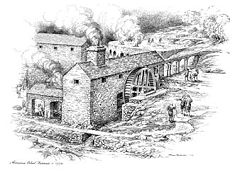
Abercarn Blast Furnace
|
|
|
|
Rudry Ironworks
The society's project in 1973 was the excavation of the furnace at the site of the Rudry Ironworks. Started by Christopher Pope of Bristol in 1828, the furnace had a short life and ceased work in 1834. Pope, who controlled most of Bristol's brass industry at the time, was declared bankrupt in 1831, and his assignees attempted to work the furnace for a few more years.The blast engine and other materials were salvaged and the buildings were abandoned. By the 1930's, all structures had been demolished. The remains have been covered and cannot be viewed, but have been listed as an Ancient Monument.
This photo shows Rudry Furnace from the top of the charging bank. The furnace was of a typical early 19th century design, a free-standing tapered square tower constructed of local pennant sandstone, with four arches, that furthest away the tymp arch for tapping the iron and slag, and three for the admittance of the cold air-blast pipes.
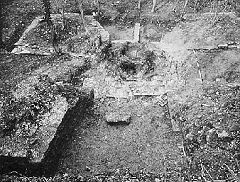
Rudry Furnace
|
|
|
|
The Penllwyn Tramroad
The society's first project was a study of the Penllwyn tramroad or John Jones's tramroad, which ran from the Sirhowy tramroad at Nine Mile Point, crossing the Sirhowy river by a fine viaduct and up the east side of the Sirhowy Valley, to collieries of John Jones's Llanarth Estate near Blackwood. Our study and history of the tramroad won second prize in the South Wales Argus local history competition in 1971.
The first photo show the tramroad viaduct across the Sirhowy River, near Wattsville. It is built of stone, with a later brick lining added in the early 1900's when the viaduct was used by the LNWR during the construction of the Nine Mile Point Colliery. The second photo shows the tramroad embankment leading from the viaduct, almost hidden in the trees, across the valley.
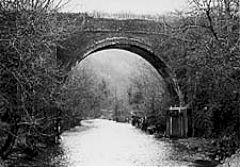 Tramroad viaduct
Tramroad viaduct
|
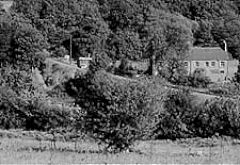 Tramroad embankment
Tramroad embankment
|
|
|
Melingriffith Water Pump
In 1974, the society, in conjunction with members of the South Wales branch of The Inland Waterways Association, began its longest project, the restoration of the Melingriffith water pump in Whitchurch, Cardiff. Water was taken from the River Taff at Radyr weir to provide water power at the Melingriffith tinplate works. The engine, which dates from 1795, pumped water from the work's tail race into the Glamorganshire Canal below Melingriffith lock. When the canal was finally shut, the pump was abandoned and the canal filled in.
Although a listed ancient monument, the structure was on the point of collapse until saved by the society. The society won a Prince of Wales's award for its work on the pump. Supported by the Prince of Wales Trust and the WDA, many thousands of pounds have been spent on restoring the pump and constructing a new water course when the original feeder disappeared under a new housing development on the site of the works.
Over the last fifteen years the pump has again deteriorated but in 2009/10 the City of Cardiff has provided money for the re-restoration of this historic monument.
Pictured here is the Melingriffith water pump as it appeared in 1974, overgrown, neglected and decaying.
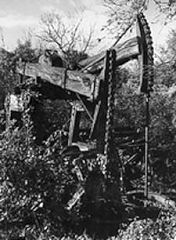
Melingriffith water pump
|
|
|
|
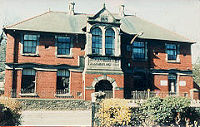



 Tramroad viaduct
Tramroad viaduct
 Tramroad embankment
Tramroad embankment
